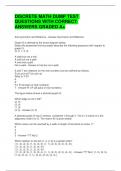DISCRETE MATH DUMP TEST
QUESTIONS WITH CORRECT
ANSWERS GRADED A+
Anti-symmetric and Reflexive - Answer-Symmetric and Reflexive
Graph G is defined by the arrow diagram below.
Select the properties that accurately describe the following sequence with respect to
graph G:
⟨2, 3, 1, 3, 4⟩
A walk but not a trail
A trail but not a path
A trail and a path
Not a walk - Answer-A trail but not a path
S and T are relations on the real numbers and are defined as follows:
S={(x,y)∣x<y}T={(x,y)∣x>y}
What is T∘S?
∅
S
R x R (all pairs of real numbers)
T - Answer-R x R (all pairs of real numbers)
The figure below shows a directed graph G:
Which edge is not in G3?
(2, 3)
(3, 4)
(1, 3)
(4, 3) - Answer-(3, 4)
A directed graph G has 5 vertices, numbered 1 through 5. The 5 x 5 matrix A is the
adjacency matrix for G. The matrix A2 is given below.
Which vertex can be reached by a walk of length 4 that starts at vertex 1?
2
4
5
3 - Answer-??? Not 2
Which relation on the set {1, 2, 3, 4} is a partial order?
{ (1, 2), (2, 3), (1, 3), (4, 3), (1, 1), (2, 2), (3, 3), (4, 4) }
{ (1, 2), (2, 3), (1, 3), (4, 3) }
{ (1, 2), (2, 3), (1, 3), (3, 4) }
{ (1, 2), (2, 3), (1, 3), (3, 4), (1, 1), (2, 2), (3, 3), (4, 4) } - Answer-??? Not { (1, 2), (2, 3),
(1, 3), (3, 4), (1, 1), (2, 2), (3, 3), (4, 4) }
, A person's birth date consists of the month, day, and year in which that person was
born. The domain for a relation R is a set of people. There are at least two people in the
group with the same birth date and at least two people with different birth dates. A
person x is related to person y under the relation if they have the same birth date or if
x's birth date is earlier than y's birth date. Which description correctly characterizes the
relation?
A partial order
A strict order and a total order
Neither a partial order nor a strict order.
A strict order - Answer-??? Not - A strict order and a total order
The domain of relation R is Z x Z. (a, b) is related to (c, d) if a-b=c-d. Which statement
correctly characterizes the relation R?
R is not an equivalence relation because R is not reflexive.
R is not an equivalence relation because R is not transitive.
R is not an equivalence relation because R is not symmetric.
R is an equivalence relation. - Answer-R is an equivalence relation.
Select the set that corresponds to the relation given in the arrow diagram below. Rows
of the matrix are numbered 1 through 4 from top to bottom and columns are numbered
1 through 4 from left to right.
{ (1, 2), (2, 2), (2, 4), (3, 3) }
{ (2, 1), (2, 2), (3, 3), (3, 4) }
{ (1, 2), (2, 3), (2, 4), (3, 3) }
{ (2, 1), (2, 2), (3, 3), (4, 2) } - Answer-{ (1, 2), (2, 2), (2, 4), (3, 3) }
The domain of a relation R is the set of real numbers. x is related to y under relation R if
|x+y|≥2. Select the description that accurately describes relation R.
Anti-reflexive
Reflexive
Neither reflexive nor anti-reflexive
Transitive - Answer-Neither reflexive nor anti-reflexive
Graph G is defined by the arrow diagram below.
Select the pair of vertices such that there is no walk of length 4 in G from the first vertex
to the second vertex.
1, 3
1, 4
2, 1
4, 3 - Answer-1, 4
S and T are relations on the real numbers and are defined as follows:
S={(x,y)∣x<y}T={(x,y)∣x>y}
What is T∘S?
T




